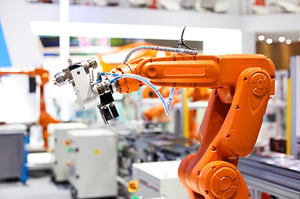Rethinking Business Models for Manufacturers
The current pandemic is a massive disruptor for the world economy, as we all know. For the manufacturing industry, it looks something like this: factory closures, supply chain disruptions, reduced production capacities, and remote work, among many other things are significantly impacting businesses in manufacturing. Let alone companies struggling with illness—and even death—among their workforce. (Of which, we offer our warmest thoughts.) While the world will eventually return to face-to-face interactions and normal shipping and production schedules, the habits that are being formed now will set a new baseline for our behaviors and expectations as consumers and professionals.

The current crisis can be seen as a dress rehearsal for a new normal that is here to stay: a world of expanded digital communication, distance learning, remote work prevalence, shifts in nationalism, and more.
This is the time to rethink and rework the tried-and-true—and sometimes decades old—business models. Companies must learn to pivot to emerge stronger and more resilient than before.
To get there, manufacturing leaders should address three important strategic shifts:
- Supply chains
- Technology
- B2B Marketing and Sales
Have you read?
How Manufacturing Companies Are Pivoting in Response to COVID-19
Communication and Marketing During COVID-19
1. Re-Assessing Supply Chains
The current pandemic has revealed that the globalized supply chain based on low costs and the just-in-time production is shockingly fragile and opens companies up to unimaginable risk exposure when interrupted. Some companies have found themselves unable to manufacture because their domestic supply chain partners relied on parts from elsewhere where the production got stuck. Moving forward, organizations need to critically assess their supply chains, regain control, and rethink how to mitigate the risks in the future. There are several ways to approach the situation, as discussed below.
Reshoring
One of the obvious ways to regain control of your supply chain is reshoring. Companies that are able to move manufacturing back domestically at competitive costs will significantly benefit by being able to quickly meet consumer demand. As discussed in one of our recent blogs, the newly emerging price equilibrium based on true total costs of offshoring, and evolving consumerism that values local manufacturing and its higher quality—especially in the case of industrial manufacturing—favor moving production back to the United States.
3D printing
Manufacturing companies that have 3D-printing capabilities have been able to pivot their production more quickly than those with traditional production lines, not to mention the decreased costs of 3D printing compared to traditional or additive manufacturing. Some companies have even leveraged their 3D-printing capabilities to produce essential medical supplies, as discussed here. Like any technological breakthrough, 3D printing comes with its fair share of skeptics; however, as the potential for these machines continues to grow with the ability to print metal, it looks as if 3D printing is here to stay … and grow.
Robotic supply chains
 Even before the pandemic, an increasing quantity of manufacturers has started implementing robotic automation for a wide number of applications, including welding, assembly, shipping, handling raw materials, and product packing. With more people working remotely domestically and the rising offshore production costs, robotic supply chains are more appealing.
Even before the pandemic, an increasing quantity of manufacturers has started implementing robotic automation for a wide number of applications, including welding, assembly, shipping, handling raw materials, and product packing. With more people working remotely domestically and the rising offshore production costs, robotic supply chains are more appealing.
Additionally, with the emergence of software technology that makes programming industrial robots for manufacturing work possible without any robotics background or coding experience, robotic supply chains become more affordable and easier to manage.
“The future of supply chain infrastructure will be focused on improving resiliency through onshoring and automation,” says Rayfe Gaspar-Asaoka, a venture capitalist at Canaan. “It’s the Zoom + Slack of manufacturing.”
Redundant suppliers
Although multinational redundancy does not prove itself effective in a multinational lockdown situation, events such as the current crisis that is affecting the entire world at once are less likely to happen in the future than single-location events. Therefore, companies that still depend on outsourcing production, at least to some extent, should diversify their partner portfolio and determine how it’s best for them to manage redundancy. Most importantly, in the post-pandemic business world as it relates to manufacturing, businesses need more insight into various components of their supply chain as well as more collaboration in terms of information and data sharing. Whether it’s a pandemic or a hurricane, manufacturers need to have transparent information available throughout the supply chain so they can proactively identify potential risk points, possible delays, and backup opportunities that provide flexibility to adapt and be more agile. It boils down to being well-prepared with data: having the information readily available in real-time, with even accessibility to all data for all parties of the supply chain, allowing all stakeholder to make informed decisions when necessary.
2. Embracing Technology
Many experts have pointed out that in a post-coronavirus world, your technology backbone will matter more than ever. Digital transformation is not simply a buzzword, it is actually happening right now—and it’s time for all businesses to embrace this change. Personalization is one of the recent years’ biggest trends: Forbes reports that 72% of buyers expect B2B companies to personalize communications in a way that suits their needs, with communications tailored to the buyer’s preferences and location in the buyer’s journey. Chatbots are one way companies are utilizing opportunities for personalization on their websites.
While brands should not see chatbots as a replacement for humaninteraction, chatbots allow you to schedule meetings and demos, resolve quick customer service issues (helping avoid lag time for responses with simple solutions), and capture lead information, saving time on both ends and creating a better customer experience. Personalized email and website content, business offers, and real-time communication will be key in the post-pandemic world.
To embrace this shift, you really do need to have (or adopt) a technology mindset and perspective. The best leaders will think about their company as a core operating system with an ecosystem of applications that supply incredible business-building freedom. Honeywell, for example, has deployed new software that enables process operations to be monitored or even executed from remote locations outside of the plant facility. “Remote support staff, working from other facilities or from home, can continue to work even when quarantines of key individuals are also affecting the availability of skilled resources at the site,” Jason Urso, CTO at Honeywell Process Solutions tells IndustryWeek.
“These remote options also use the power of Honeywell Forge offerings to proactively detect issues and bring them to the attention of both the customer and Honeywell experts whether through intelligent wearables, video assistance training or access to on-call experts. Today, we are providing this out of necessity, but tomorrow, it will be in the name of efficiency. In addition to the distribution of knowledge, there will be an increased use of a technology companion that augments human intelligence,” says Urso. “By capturing our knowledge and best practices, technology can help optimize your operational future, allowing workers to avoid issues that cause lost capacity or unplanned downtime.”
Urso provides an analogy between Google Maps and their new software: just how Google Maps provides insight on alternate directions to take because it can see traffic before you encounter it, Honeywell’s new software uses data analytics and digital twin representations of a process or equipment to avoid any issues.
The pandemic has given companies opportunities to test their limits and learn what can be done differently and more efficiently using today’s advanced technology. By using technology, organizations can augment human capabilities and create another inflection point in manufacturing in terms of performance, reliability, and safety, while also enhancing human effectiveness.
3. Rethinking B2B Marketing and Sales
Now is the time for all businesses, especially in the B2B sector, to embrace digital changes and focus on how they can build and develop strong relationships with customers and prospects that don’t rely on face-to-face events. Inbound marketing provides a great foundation for building strong relationships with customers and prospects by utilizing high-quality content and personalization through different channels, including video.
Not surprisingly, the demand for video conferencing apps has surged in recent weeks, with enterprise-focused mobile app downloads reaching 62 million during the week March 14 through 21—the highest number ever seen. Even before the pandemic arrived, research showed the demand for collaboration software and video conferencing tools was already on the rise. And with social distancing eliminating real-life interactions, video has become the new face-to-face. Having your marketing and sales teams embrace video encouraging customers to embrace video; and navigating a new normal as it relates to digital connecting, engaging, and sharing is vital in the post-pandemic business model.
Product demonstrations, announcement events, Q&A sessions, and other types of traditionally face-to-face events can be transitioned to live-stream format. In fact, many companies are already hosting events that normally happen from the stage in live-stream and on-demand video format. Sales training meetings, video group collaborations, brainstorming sessions are just a few examples of how you can use video to your advantage to be more efficient and effective as it’s required in today’s world.
The key is realizing that customers, employees, prospects, and stakeholders are all dealing with the same challenges these days, and acquiring the same habits as it relates to communicating digitally. When B2B companies realize the new reality of business challenges their customers and employees face, and embrace these changes in new and innovative ways, that can make a big difference—both in their ability to market and sell and in their ability to survive and ramp-up production.
If anything, Covid-19 has once again reminded us how important it is to be flexible and embrace changes, even in such traditionally stable industries as industrial manufacturing. Companies that hurry back to old ways of working may very well stumble in the decade to come. The current pandemic has given us opportunities to rethink the way we operate and rework old models. Whether it’s reassessing the efficiency of your supply chain, bringing your technology up-to-date, or learning new ways to market and sell, be mindful about the changes and start small, but have a big picture for where your business is heading. The world has changed, and the leading companies will be the ones that adapt to the new normal faster than others. Better yet, possibly pioneer what new normal looks like for manufacturing. Embrace the changes … and create some.
Prepared for the Future
The COVID-19 outbreak has caused tremendous upheaval around the world. To continue providing value, organizations need to ensure that employees, customers, and all stakeholders in the supply chain are adequately informed. As the intensity of the crisis subsides, we may have found that we’ve created contingency strategies and new working models—some temporary, some we may realize are better that what we originally had. Either way, we need to come out of this with new tactics to dealing with unexpected crisis and empowered approaches to maintaining effective, efficient operations during challenging times. In a nutshell: prepare for the future.
As you consider the preparedness of your working model now and into the future, we can help you re-assess your marketing and sales strategies, allowing you to communicate more efficiently and effectively with your customers. Get in touch with us today to discuss your evolving situation and we’ll work with you to figure out what preparing for the future should look like for you and your company … now.


